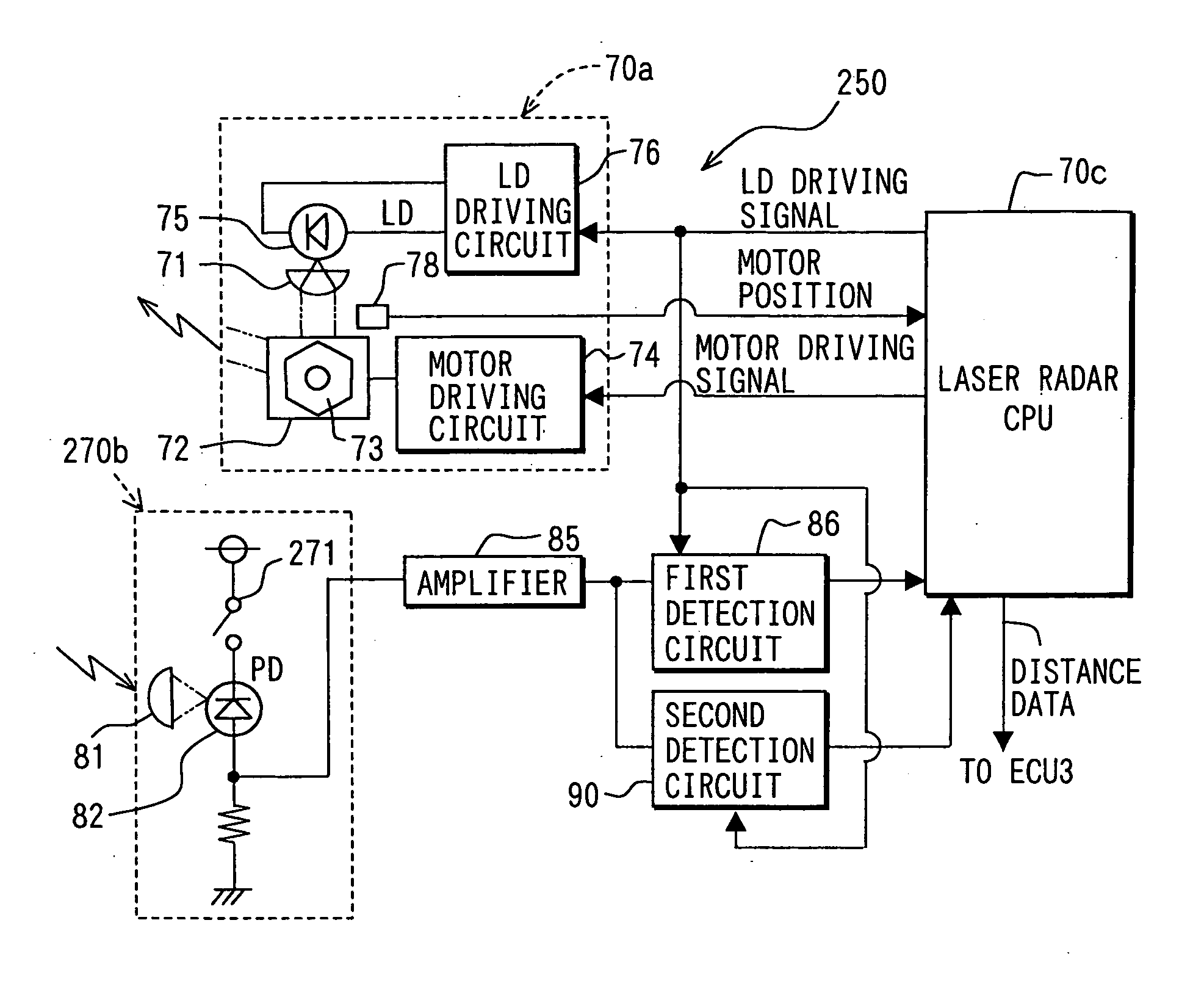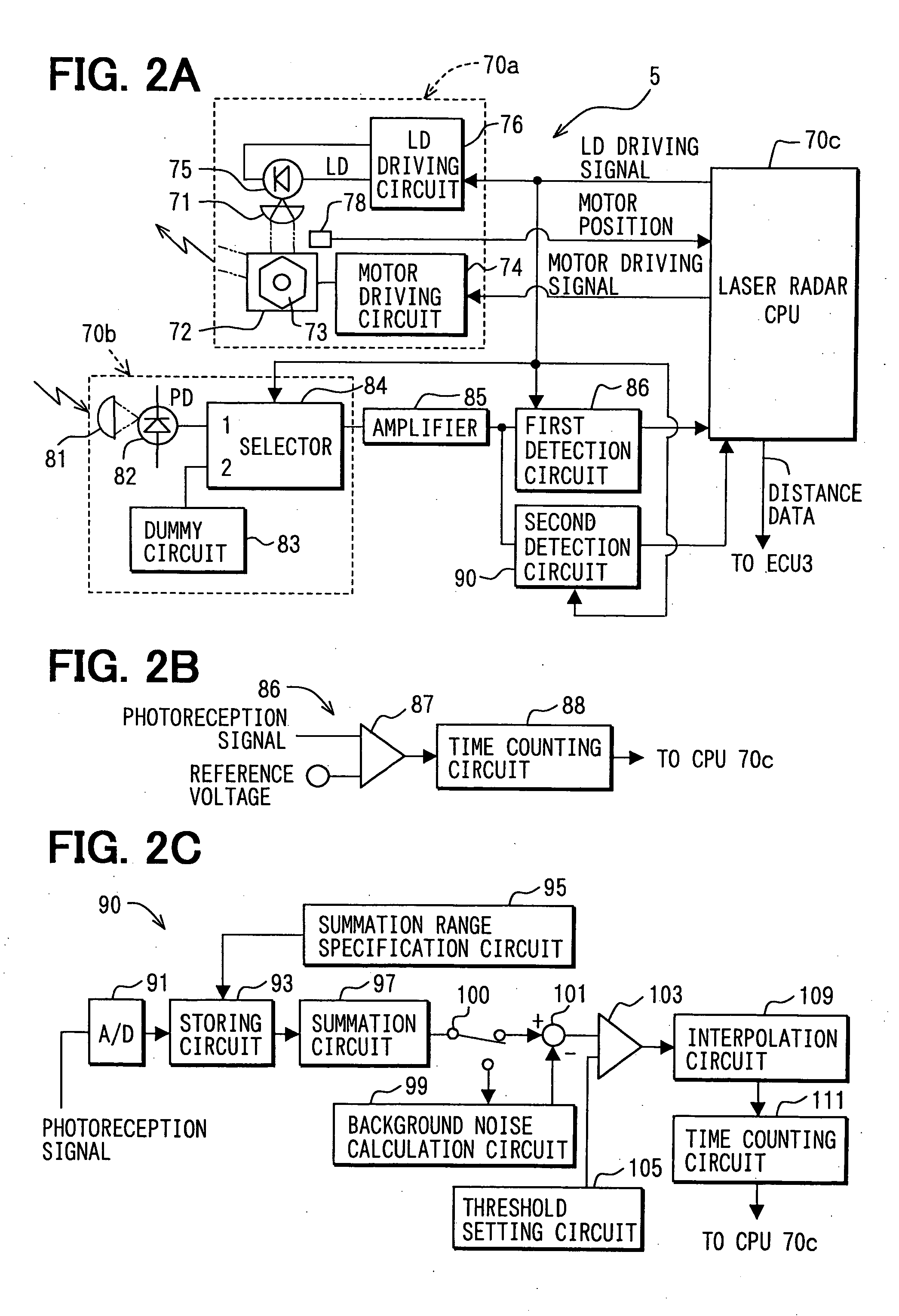Radar device
a radar and device technology, applied in the field of radar devices, can solve the problems of large limiting factor and decrease in the performance of radar devices, and achieve the effect of reducing the limiting factor in the optical system design
- Summary
- Abstract
- Description
- Claims
- Application Information
AI Technical Summary
Benefits of technology
Problems solved by technology
Method used
Image
Examples
first embodiment
[0028] Referring to FIG. 1, a vehicle control system 1 includes an object recognition and cruise control electronic control unit (ECU) 3. The ECU 3 has a microcomputer as a main component, and has an input and output interface (I / O) and various driving and detection circuits.
[0029] The ECU 3 receives signals from a laser radar sensor 5, a speed sensor 7, a brake switch 9, and a throttle sensor 11. The radar sensor 5 is a radar device. The ECU 3 outputs driving signals to an alarm generating unit 13, a distance displaying unit 15, a sensor error displaying unit 17, a brake actuating unit 19, a throttle actuating unit 21, and an automatic transmission control unit 23.
[0030] An alarm volume control unit 24, an alarm sensitivity setting unit 25, a cruise control switch 26, a steering sensor 27, and a yaw rate sensor 28 are connected to the ECU 3. The alarm volume control unit 24 controls a volume of an alarm sound. The alarm sensitivity setting unit 25 controls sensitivity in an alarm...
second embodiment
[0075] Referring to FIG. 10, a laser radar sensor 150 includes a light receiving circuit 170b. Other configurations are the same as the first embodiment, and therefore only the configuration of the light receiving circuit 170b will be discussed.
[0076] The light receiving circuit 170b does not include the dummy circuit 83 and the selector 84 that are included in the light receiving circuit 70b of the first embodiment. The photoreception signals outputted from the photoreceptor 82 are directly inputted to the amplifier 85. Furthermore, a light emitting device 140, for example, a light emitting diode, is arranged adjacent to the photoreceptor 82.
[0077] The light emitting device 140 emits light toward the photoreceptor 82 and the photoreceptor 82 is lighted with high intensity of light. Thus, the photoreceptor 82 can be saturated, and the photoreceptor 82 does not output signals in response to incident light when light is emitted from the light emitting device 140. Namely, the photore...
third embodiment
[0080] Referring to FIG. 11, a laser radar sensor 250 includes a light receiving circuit 270b. Other configurations are the same as the first embodiment, and therefore only the configuration of the light receiving circuit 270b will be discussed.
[0081] The light receiving circuit 270b does not include the dummy circuit 83 and the selector 84 that are included in the light receiving circuit 70b of the first embodiment. The photoreception signals outputted from the photoreceptor 82 are directly inputted to the amplifier 85. Furthermore, a switching device 271, for example, a transistor, is connected in a power supply line for feeding bias current to the photoreceptor 82.
[0082] The bias current supply to the photoreceptor 82 is controlled according to turning on and off of the switching device 271. Levels of the photoreception signals, namely, output voltages, corresponding intensity of incident light of the photoreceptor 82 greatly changes according to the bias current whether it is ...
PUM
 Login to View More
Login to View More Abstract
Description
Claims
Application Information
 Login to View More
Login to View More - R&D
- Intellectual Property
- Life Sciences
- Materials
- Tech Scout
- Unparalleled Data Quality
- Higher Quality Content
- 60% Fewer Hallucinations
Browse by: Latest US Patents, China's latest patents, Technical Efficacy Thesaurus, Application Domain, Technology Topic, Popular Technical Reports.
© 2025 PatSnap. All rights reserved.Legal|Privacy policy|Modern Slavery Act Transparency Statement|Sitemap|About US| Contact US: help@patsnap.com



